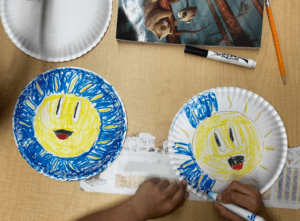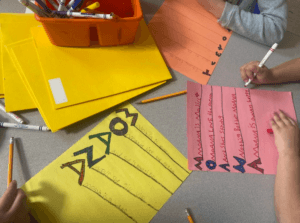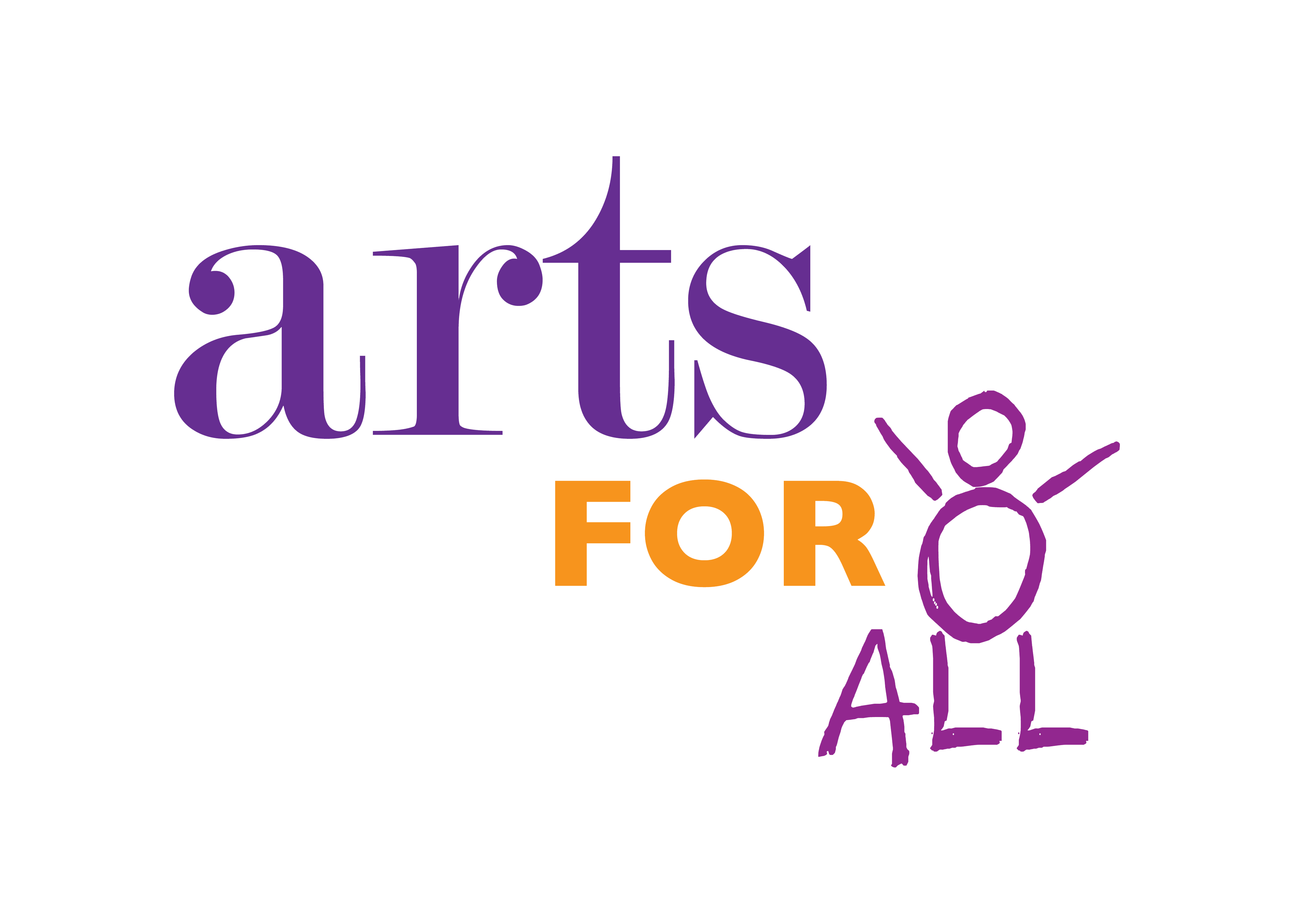Written by AFA Spring 2023 Intern Melody Fay Browning
February 9th, 2023

Photo By Melody Fay Browning
On Thursday, February 9th I had the joy of joining teaching artist Kim Schafer at PS 15 for a second-grade class. The class had been talking about Encanto, so Kim started out by asking the children to remind her what special powers Mirabel had. She then asked the children to go around and say one thing that makes them special. Many of the children said they were smart or a good friend. There were several children who were shy or didn’t know what to say, and one little boy in the class made sure to tell them what he thought was special about them. It was so heartwarming to see the way this boy went out of his way to make his classmates feel seen and special. The class then spent the rest of their time making DIY tambourines. They used two paper plates and stapled them together with bells on the inside to make noise. They also decorated the outside with markers with whatever design they liked. This class was very energetic, and it was great to see the way they responded to Kim’s activities with such excitement and engagement.
Teaching Artist Kim Schafer Interview Part 1:
Q: What factors do you think about when developing your lesson plans?
Kim: There’s a lot of those factors. Yeah. I think of the age group, which is a huge factor. Especially because, depending on how young and how old they are, the younger kids are just much more open to embracing every style of art. Whereas, as you get older, for boys, it tends to sometimes get a little iffy when you’re asking them to dance or sing or do things that are just a little bit more putting yourself out there, a little bit more vulnerable. Because, as you get older, kids think is it cool to dance? So that’s my biggest thing when I think about what I’m going to plan. What the age group is, then what art form they’re going to embrace most. When I was thinking about the literacy program this time, I wanted to do books that I could find common ground on with the theater arts, meaning it’s very easy to turn a Disney story into a song and dance and scripts and drama activities because it already lends itself into that rather than taking a serious book. I knew that some of these Disney stories were going to be familiar, and I feel like that helps the kids relate to it because they get excited and say, “I’ve heard of that”. “Oh, I’ve heard of Moana. Oh, I’ve heard this song once.” And that helps them get excited about the program and about the activities that I’m asking them to do. I try to pick stuff that’s not as obscure, but that still can be very powerful and very meaningful, and that I can do every style of art because now that I’m not just doing my dance residencies, I like to do a little bit of everything. I like to do drama games. I like to do readers theater scripts. I like to do dances. I like to teach a little bit about music. So, I kind of use all of my experience for the kids.
Q: How do you navigate classrooms with children that are at different levels of learning and skill?
Kim: That is a very difficult thing to do. I think you probably saw it sometimes when you came and witnessed. I think the thing is trying to make well-rounded activities that whether or not they can understand and participate in the entire activity, at least they’ll be able to do half of it. Making sure that the lesson plan has activities that everyone can participate in and where there’s are activities that are going to challenge some of the students as well. I think my most difficult challenge these days is that I have a couple of students that only speak Spanish. Luckily one of the teachers can kind of translate for me. Learning a couple of different words so that at least they understand where I’m going with it. But I’ve also tried to do either art projects or dance or movement or more of those type of projects rather than reading and writing.
Q: What do you hope children in your classes take away from your lessons?
Kim: Overall, my hope is just for them to find the joy of the arts and why people love it so much. There’s a reason why I’ve been doing it for 40 years. It’s because I love to do it. It’s a passion. I think that especially for these students that don’t get exposed to it, I think the creativity that opens up inside of them is a really huge thing because I think that helps them with all other subjects in school and to become a more well-rounded person in general. You can see when we’re working on some of the activities the empathy that some of the students have. And like one day I asked the kids what makes each person special, and it was awesome because some of them were like naming stuff about each other. And so, I think it makes you a better human being.
March 16th, 2023

Photo By Melody Fay Browning
Today I had the pleasure of Joining teaching artist Kim Schafer for two second-grade classes. The first class had been discussing Moana, so after a quick thumbs up or down check-in, Kim started off the class by reviewing the different characters we see in the film. The children took turns reminding the rest of the class about the traits and powers of each character. Then Kim explained that the class would be creating their own acrostic poems, which is a kind of poem where the first letters of each line spell out a word. Each student picked a character and wrote their poem about the traits and personality of that character. The class was challenged by this activity, particularly when it came to thinking of ideas and spelling, but they had a great time and made poems that they seemed to be very proud of. In the next class, the group read a short book about Moana to get a sense of the story, then discussed some Hawaiian cultural references and phrases like “Aloha.” Next, the class was tasked with creating their own flower-shaped mosaics inspired by Hawaiian leis. The class used stickers and gems to create their art pieces. Both groups had a lot of fun, and were very excited about exploring Moana, a story with such fun and inspiring characters.
Teaching Artist Kim Schafer Interview Part 2:
Q: I had a question about something you touched on with our first set of questions. The first time I visited your class I really loved your check-in with the kids when you asked them to name one thing that makes them special. It was so sweet to see the way they answered and the way some of the kids answered for their friends when they were too shy. What do you think it’s important to do these check ins with your classes?
Kim: It’s funny that you ask that because I think the old school way of teaching and even some of the way I was brought up and the teachers that I had, it was always hard, tough love. And I just realized through my many years of teaching, is that you can get more out of students and kids, and even adults if it is affirmative, positive love followed with pushing them. The way I teach in all of my classes, whether it’s kindergartners up until my college kids, is that I expect a certain level and I expect them to work really hard for me. But there’s always going to be affirmations with that because I think that if you tell a student, you are doing so great, I am so proud of you, now, can you try this and do it a different way? And if you go about it this way, that can really be a turning point for students. So I think it’s a balance.
Q: That actually leads right into my next question. The art projects that the classes we were working on were really creative and really fun. They seemed to have like a great time with them, but also, they seemed to challenge them in a really great way. I was curious about that balance between having fun but also being challenged and how you find that balance?
Kim: Well, usually I teach towards the higher, more advanced students because what I see is that students would much rather be pushed in a positive way than bored and doing the same thing over and over again. Maybe it won’t be perfect and that’s fine. I tell my students all the time, if you all were perfect, then why do you need me? Class is the time to try stuff and to fail and to try it again and to succeed. I think that’s a really important thing when it comes to all of my classes, like this might be difficult, this might be tricky, this might put you out of your comfort zone, but where else are you going to do that? Especially dealing with the arts. Where are you going to get a chance to do that if it’s not in class and if it’s not a safe space? And I try to do some of those harder activities later on in the semester or the year, because at that point they trust me.
Q: In the classes I visited, you focused on the themes of Encanto and then Moana, and I really liked how you took time to talk about the cultures that both of these films are based in. How do you approach that with 2nd grade aged children and why do you think it’s important?
Kim: Obviously, diversity is super important, and where we’re teaching these classes, it’s a very diverse community. I think it’s very important to talk about it and to normalize it and to say that that’s actually what makes us all special. And so I think that talking about the fact that Moana is Hawaiian and talking about the cultural roots just emphasizes the fact that being different from the next student or the next kid is cool. I think that’s really important to instill in young kids that that’s what makes us special and that we should love that part of ourselves.
